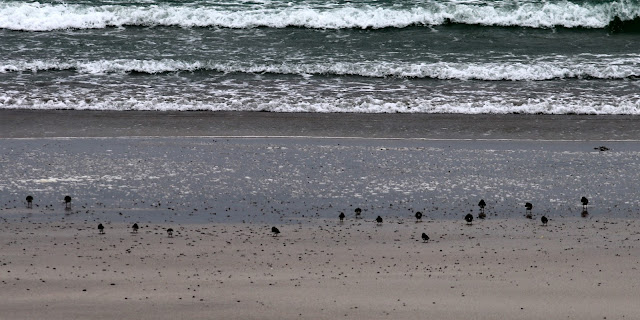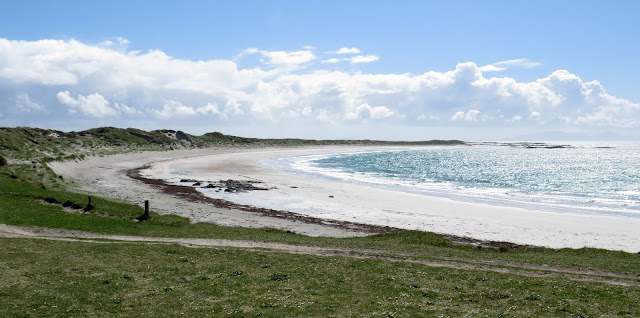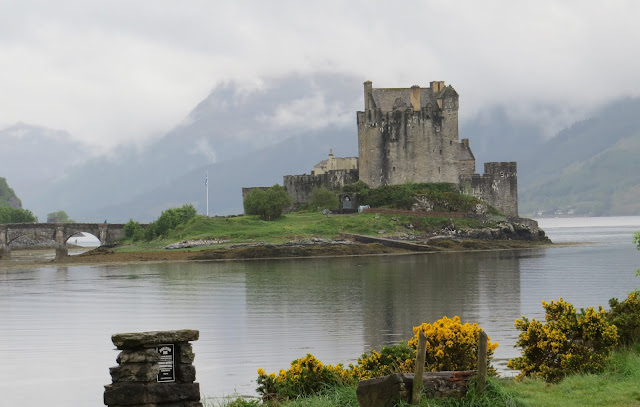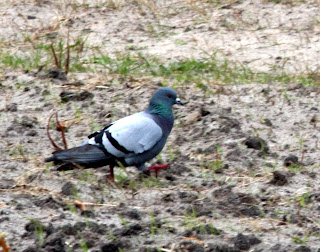Tiree Experience
Monday May 15
Not much to write about to-day - except to express the British obsession with the weather.
Hebrideans say that when the wind stops blowing on Tiree, all the inhabitants fall over. We had to struggle to stay upright IN the wind. It's been blowing a real gale here to-day with intermittent rain. Not cold, peculiarly, due to the southerly wind. I had to hold the car door open so that Pam could get in.
It was lunchtime before we left the cottage with several chores in mind. Stamps for the postcards and a battery for my watch. I must be able to get one somewhere.
A shop assistant at Bayhead, down the road, said that their post office was shut as it only opened on Monday and Friday mornings until noon. The main Post Office was in Lochmaddy. I should be able to get a battery in Benbecula.
And..... having driven the 20 miles there especially, the Lochmaddy Post Office also closed at noon every day and it was now 1 p.m. How helpful !!!
There's a large RAF station on Benbecula, we've always bypassed that western turning before. We found a very large settlement, many times larger than any other on these linked islands. Pam found the best supemarket too, McLennans, which was reminiscent of a Waitrose in its contents, layout and quality. Another enquiry pointed us to a Hardware shop 'straight ahead on the way out'. And there it was. Pam took my watch in, five minutes later I was strapping on a working timepiece, costing the princely sum of £3.99. Great.
No point in further exploration in the conditions.
Starved of birds, we couldn't resist Balranald and Aird an Runair beach. One other vehicle only at the bay. Ringed Plovers, Sanderling and Turnstone scattered on the low tide shoreline,
one Great Northern Diver, a few Common Terns flying by, Red-breasted Merganser and Eider resting on the beach.
Seaweed is scattered on the ploughed machair as a fertiliser.
Machair is a Gaelic word meaning fertile low lying grassy plain. This is the name given to one of the rarest habitats in Europe which only occurs on exposed western coasts of Scotland and Ireland. Machair habitats in the Outer Hebrides run up the western shores of Uist, Harris and Lewis. North Uist is noted as having some of the finest examples.
Here sand, largely made up of crushed shells, is regularly blown ashore by Atlantic gales. Over time the calcium rich shell sand and traditional Outer Hebrides crofting land practices have led to the development of a mosaic of fertile Scottish grassland habitats renowned for its Outer Hebrides wildflowers, Western Isles birds and insect life.
The most extensive areas of Outer Hebrides machair can be found on the West Coast of the Uists.
Hebrideans say that when the wind stops blowing on Tiree, all the inhabitants fall over. We had to struggle to stay upright IN the wind. It's been blowing a real gale here to-day with intermittent rain. Not cold, peculiarly, due to the southerly wind. I had to hold the car door open so that Pam could get in.
It was lunchtime before we left the cottage with several chores in mind. Stamps for the postcards and a battery for my watch. I must be able to get one somewhere.
A shop assistant at Bayhead, down the road, said that their post office was shut as it only opened on Monday and Friday mornings until noon. The main Post Office was in Lochmaddy. I should be able to get a battery in Benbecula.
And..... having driven the 20 miles there especially, the Lochmaddy Post Office also closed at noon every day and it was now 1 p.m. How helpful !!!
There's a large RAF station on Benbecula, we've always bypassed that western turning before. We found a very large settlement, many times larger than any other on these linked islands. Pam found the best supemarket too, McLennans, which was reminiscent of a Waitrose in its contents, layout and quality. Another enquiry pointed us to a Hardware shop 'straight ahead on the way out'. And there it was. Pam took my watch in, five minutes later I was strapping on a working timepiece, costing the princely sum of £3.99. Great.
No point in further exploration in the conditions.
Starved of birds, we couldn't resist Balranald and Aird an Runair beach. One other vehicle only at the bay. Ringed Plovers, Sanderling and Turnstone scattered on the low tide shoreline,
one Great Northern Diver, a few Common Terns flying by, Red-breasted Merganser and Eider resting on the beach.
Seaweed is scattered on the ploughed machair as a fertiliser.
Machair is a Gaelic word meaning fertile low lying grassy plain. This is the name given to one of the rarest habitats in Europe which only occurs on exposed western coasts of Scotland and Ireland. Machair habitats in the Outer Hebrides run up the western shores of Uist, Harris and Lewis. North Uist is noted as having some of the finest examples.
Here sand, largely made up of crushed shells, is regularly blown ashore by Atlantic gales. Over time the calcium rich shell sand and traditional Outer Hebrides crofting land practices have led to the development of a mosaic of fertile Scottish grassland habitats renowned for its Outer Hebrides wildflowers, Western Isles birds and insect life.
The most extensive areas of Outer Hebrides machair can be found on the West Coast of the Uists.
We are too early for the flowers, apart from daisies. June is the optimum time.
Foraging quietly in the seaweed, summer plumaged Turnstones are almost invisible.
Foraging quietly in the seaweed, summer plumaged Turnstones are almost invisible.
Ringed Plovers less so, as their distinctive dot dash dot movement makes them more discernible.
Pam heard one Corncrake and we saw a couple of Snipe, even the birds were subdued by the tumult. No moth-ing to-night, these are the worst flying conditions.
I actually found out how to work the TV to-night, so that we could watch a documentary about the survival techniques of miniature beasties. A bit too much sea life for me, apart from the Hermit Crabs bit which was fascinating. Well worth a watch.






Comments
Post a Comment